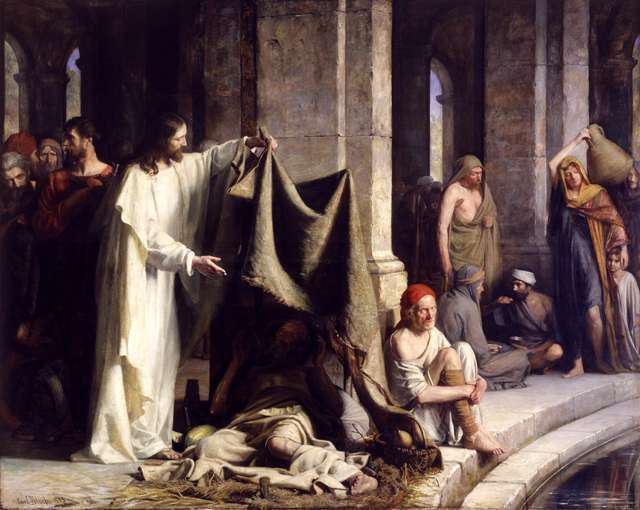The representation of man’s relationship with the divine has changed dramatically throughout the centuries. Consider the “everyman” protagonist of Fall and Redemption of Man and his elevated role in the artwork, both theologically and compositionally. Artists’ responses to the anguished question of mankind’s ultimate destiny depend largely on the historical and cultural realities of their time.
Compare the innocent Christ child and his mother in Madonna and Child with the definition of the trinity presented in Artus Wolffort’s work. What cultural factors may have influenced the artist’s choice in featuring various aspects of God’s nature? Later works in this gallery, such as Christ Healing the Sick at Bethesda and The Crucifixion: A Triptych show a broad spectrum of humanity and their various reactions to the Savior. In the Shaping America exhibition, find Lift Up Thine Eyes and consider the artist’s views on the status of man’s relationship with the divine in the modern world.
School of Lucas Cranach (1472–1553) – Fall and Redemption of Man
Gift of Karel Waterman

Circle of Artus Wolffort (1581–1641) The Trinity
Purchase/gift of Gloria Teichert with funds provided by Jack R. and Mary Lois Wheatley

Carl Heinrich Bloch (1834–1890) Christ Healing the Sick at Bethesda
Purchased with funds provided by Jack R. and Mary Lois Wheatley

Bernard Sleigh (1872–1954) The Crucifixion: A Triptych
Purchased with funds provided by Verla Birrell and Campbell Foundation

YOU MAY NOTICE
The significance of man’s plight in Cranach’s Fall and Redemption of Man is indicated by the centrality of the figure who represents “everyman.” On either side, Moses and John the Baptist point toward Christ, indicating his central role in our salvation. The fears, concerns, and anxieties that plague “everyman,” are the subject of this work, reflecting the prevalence of humanism at this time.
Madonna and Child is reflective of the Renaissance interest in humanism and attempt to bring man closer to the divine. The Trinity represents a reaction to the hubris of mankind, the very spirit of the Counter-Reformation. The work sought to reinforce the authority of the Catholic faith, particularly through the sacrament of the Eucharist, or the literal blood and body of Christ.
Later works such as Christ Healing the Sick at Bethesda represent various attitudes toward Christ and his ministry. While some individuals hover and even crawl toward Christ on hands and knees, others remain oblivious to the miracles of the Savior. Many direct their attention away from The Living Water toward the pool of Bethesda, which tradition said contained healing powers. These varying reactions to the Savior showcase the different attitudes that mankind have toward God.
Sleigh’s work is an early twentieth-century triptych, or tri-part altarpiece, typical of the medieval era. The physical setting is vague and its geographic location unclear. People from different time periods–including soldiers, kings, judges, and prisoners–gather to kneel before their king. This artwork is a reminder of the timeless Christian doctrine that regardless of worldly station, all are equally in need of salvation.
Norman Rockwell’s Lift Up Thine Eyes shows New Yorkers on their daily trek walking by St. Thomas Church. In a caricaturist manner, they hurriedly shuffle toward their next destination; heads cast down without even noticing the architectural and implied spiritual beauty that surrounds them.

